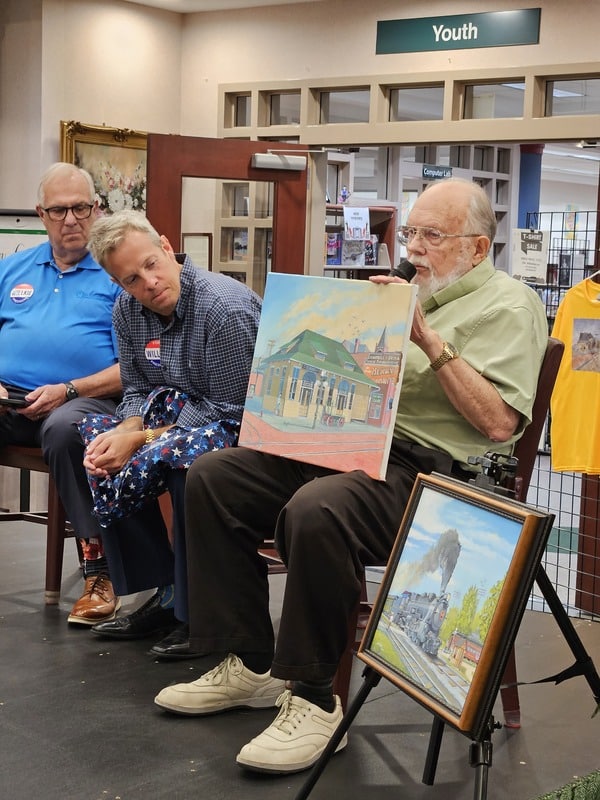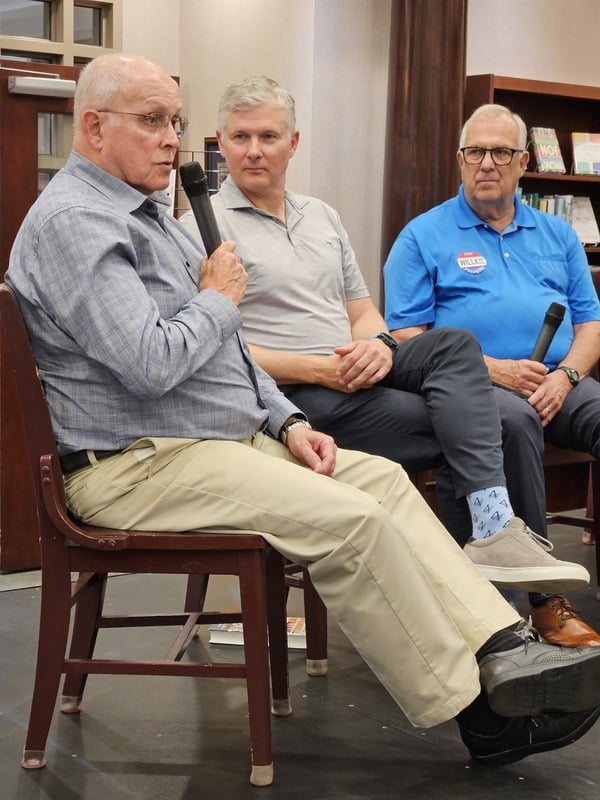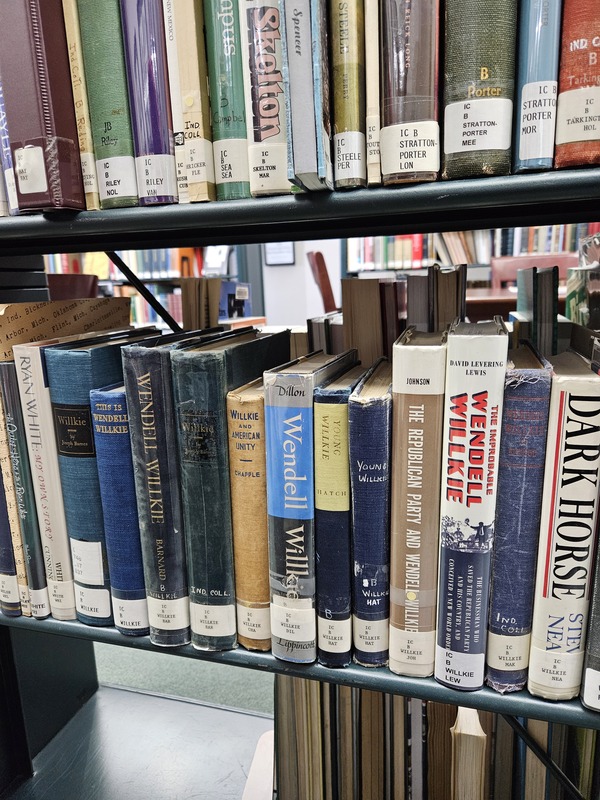
By Marilyn Odendahl
The Indiana Citizen
August 21, 2024
Eight-four years after he returned to his boyhood home of Elwood, Indiana, on Aug. 17, 1940, to give his speech accepting the Republican Party’s presidential nomination, Wendell Willkie can still attract a crowd.
The Hoosier did not have an easy path to the nomination – he was selected after six votes during the GOP’s contentious national convention in Philadelphia in June of that year – and faced an even more difficult path to the White House, running against – and ultimately losing to – Democrat Franklin Delano Roosevelt. However, arriving in Elwood by train and traveling by motorcade to Callaway Park on that August day, Willkie was greeted by an overflowing crowd of fans and supporters.
To mark the 84th anniversary of that speech, the Elwood Public Library hosted a panel discussion on Saturday. Lou Gerig, former press secretary of U.S. Sen. Dick Lugar and former assistant press secretary in the Ronald Reagan administration, moderated the talk, which recounted the day of Willkie’s speech and its significance in the history of presidential campaigns. The panelists were Stephen Jackson, historian; Michael McQuillen, collector of Willkie memorabilia; Marvin Crim, local artist; and David Willkie, grandson of the presidential candidate.
As part of the event, the Kikthawenund Chapter of the National Society Daughters of the American Revolution in Madison County presented David Willkie with the Women in History Award in honor of his trailblazing grandmother: Wendell’s mother, Henrietta Trisch Willkie. As a young mother of eventually six children, she changed her career path to study law and obtained her law license in June 1897, becoming the first woman to practice law in Madison County.
Also, Crim unveiled his painting of the train that Willkie rode into Elwood to give his acceptance speech.

These days, politicians are happy to have 15,000 or 30,000 at a campaign rally, Gerig pointed out, but Willkie’s crowd swelled to an estimated 250,000. A photograph taken during Willkie’s speech shows a sea of people and, according to Jackson, the two-lane state roads 13 and 28 were turned into one-way streets with traffic headed into Elwood on the morning of Aug. 17 and out of the community in the afternoon. Also, Jackson said, the railroads ran 35 extra trains into Elwood that day and the northwest corner at the intersection of state roads 28 and 213 became a landing field for 250 airplanes.
“He was a very charismatic individual,” Jackson said of Willkie. “When you read about his life and the excitement that his presence generated around people, he had to be somebody extremely charismatic. I think that was his appeal.”
A crowd – albeit much smaller – turned out for the discussion on Saturday afternoon. Mostly senior citizens filled the plastic chairs arranged in neat rows on the main floor of the library, but sprinkled in were a few families with young children.
Born in Elwood in 1892, Willkie was considered a dark horse presidential candidate, according to the biography that James Madison, professor emeritus of history at Indiana University Bloomington, wrote for “Indiana 200: The People Who Shaped the Hoosier State.” He was “fresh and eager,” and while he echoed the Republican Party’s criticism of Roosevelt’s New Deal, he set himself apart from the Midwestern GOP’s isolationism by advocating for the country to help its allies confront Hitler.
Two years after he lost the election, Willkie boarded a military plane, at Roosevelt’s request, and traveled around the world to meet with leaders in the Middle East, Africa, the Soviet Union and China, according to Madison.
“My grandfather thought that there are no distant places in the world anymore,” David Willkie explained after the discussion. “If you affect somebody someplace, you affect somebody every place.”
Despite his charisma and what Madison noted were his superb oratory skills, Willkie was not especially inspiring in Callaway Park. Maybe he was overcome by the unusually hot day as the temperatures soared to 102 degrees, or he was disheveled from leaving his speech at his mother-in-law’s house in Rushville and then having to send the police on a mad dash to retrieve it, but, Madison wrote, Willkie’s remarks were “a bit dull.”

Although the speech has largely been forgotten, Willkie’s arrival and motorcade through a cheering throng continues to capture history’s attention. Willkie stepped off the train that had carried him and his family members from Rushville to Elwood that morning and was driven to the high school, where he met with his former classmates. From there, he was taken to Callaway Park.
Along the parade route, Willkie stood in the open-top car, took his straw hat off and waved to the crowd. A photographer captured the moment and the “look of amazement” on Willkie’s face, Jackson said, in what Life magazine called the greatest American political campaign photograph of all time.
Jackson has researched Willkie’s visit, discovering details like the route the presidential candidate took through the town and the number of folding chairs that Noland Wright, the future mayor of Anderson, had ordered to be placed in the park (30,000).

Most importantly, Jackson said, he has collected stories about that day from individuals and families who either were there or had relatives there. The tales underscore the size of the crowd. One story recounts a man giving a passerby a drink from his garden hose for a nickel and then seeing a long line form of other people wanting a sip. Another story tells about a man who gave rides to Callaway Park to scores of reporters who thanked him by stuffing dollar bills into his pockets.
“I’m kind of amused today by our two candidates that are running for president now, who are so excited about the crowd size that they get and they like to go back and forth about that,” Jackson said. “They can’t hold a candle to what Willkie did.”
Dwight Adams, an editor and writer based in Indianapolis, edited this article. He has been a content editor, copy editor and digital producer at The Indianapolis Star and IndyStar.com, and a planner for other papers, including the Louisville Courier Journal.
The Indiana Citizen is a nonpartisan, nonprofit platform dedicated to increasing the number of informed and engaged Hoosier citizens. We are operated by the Indiana Citizen Education Foundation, Inc., a 501(c)(3) public charity. For questions about the story, contact Marilyn Odendahl at marilyn.odendahl@indianacitizen.org.